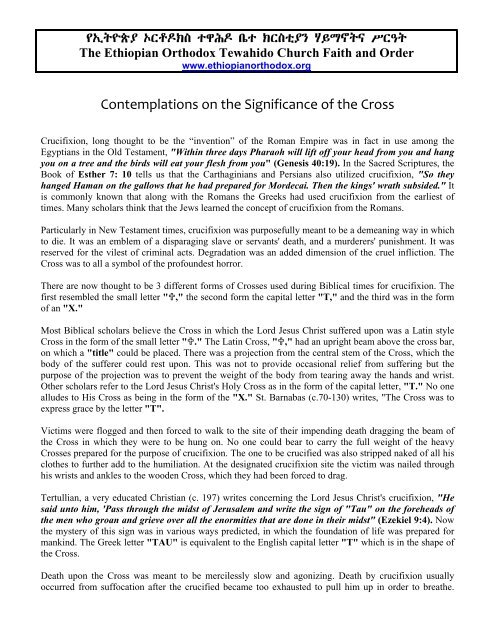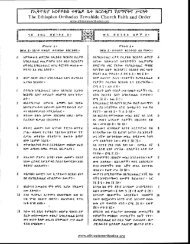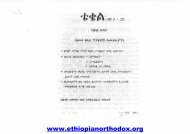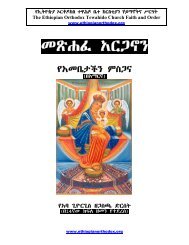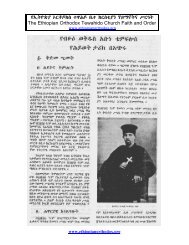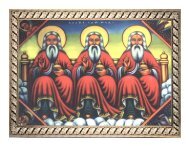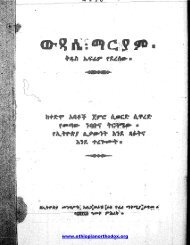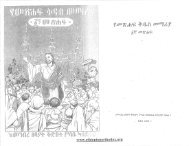Significance of the Cross - The Ethiopian Orthodox Tewahedo Church
Significance of the Cross - The Ethiopian Orthodox Tewahedo Church
Significance of the Cross - The Ethiopian Orthodox Tewahedo Church
You also want an ePaper? Increase the reach of your titles
YUMPU automatically turns print PDFs into web optimized ePapers that Google loves.
<strong>The</strong> <strong>Ethiopian</strong> <strong>Orthodox</strong> Tewahido <strong>Church</strong> Faith and Order<br />
www.ethiopianorthodox.org<br />
Contemplations on <strong>the</strong> <strong>Significance</strong> <strong>of</strong> <strong>the</strong> <strong>Cross</strong><br />
Crucifixion, long thought to be <strong>the</strong> “invention” <strong>of</strong> <strong>the</strong> Roman Empire was in fact in use among <strong>the</strong><br />
Egyptians in <strong>the</strong> Old Testament, "Within three days Pharaoh will lift <strong>of</strong>f your head from you and hang<br />
you on a tree and <strong>the</strong> birds will eat your flesh from you" (Genesis 40:19). In <strong>the</strong> Sacred Scriptures, <strong>the</strong><br />
Book <strong>of</strong> Es<strong>the</strong>r 7: 10 tells us that <strong>the</strong> Carthaginians and Persians also utilized crucifixion, "So <strong>the</strong>y<br />
hanged Haman on <strong>the</strong> gallows that he had prepared for Mordecai. <strong>The</strong>n <strong>the</strong> kings' wrath subsided." It<br />
is commonly known that along with <strong>the</strong> Romans <strong>the</strong> Greeks had used crucifixion from <strong>the</strong> earliest <strong>of</strong><br />
times. Many scholars think that <strong>the</strong> Jews learned <strong>the</strong> concept <strong>of</strong> crucifixion from <strong>the</strong> Romans.<br />
Particularly in New Testament times, crucifixion was purposefully meant to be a demeaning way in which<br />
to die. It was an emblem <strong>of</strong> a disparaging slave or servants' death, and a murderers' punishment. It was<br />
reserved for <strong>the</strong> vilest <strong>of</strong> criminal acts. Degradation was an added dimension <strong>of</strong> <strong>the</strong> cruel infliction. <strong>The</strong><br />
<strong>Cross</strong> was to all a symbol <strong>of</strong> <strong>the</strong> pr<strong>of</strong>oundest horror.<br />
<strong>The</strong>re are now thought to be 3 different forms <strong>of</strong> <strong>Cross</strong>es used during Biblical times for crucifixion. <strong>The</strong><br />
first resembled <strong>the</strong> small letter "," <strong>the</strong> second form <strong>the</strong> capital letter "T," and <strong>the</strong> third was in <strong>the</strong> form<br />
<strong>of</strong> an "X."<br />
Most Biblical scholars believe <strong>the</strong> <strong>Cross</strong> in which <strong>the</strong> Lord Jesus Christ suffered upon was a Latin style<br />
<strong>Cross</strong> in <strong>the</strong> form <strong>of</strong> <strong>the</strong> small letter "." <strong>The</strong> Latin <strong>Cross</strong>, "," had an upright beam above <strong>the</strong> cross bar,<br />
on which a "title" could be placed. <strong>The</strong>re was a projection from <strong>the</strong> central stem <strong>of</strong> <strong>the</strong> <strong>Cross</strong>, which <strong>the</strong><br />
body <strong>of</strong> <strong>the</strong> sufferer could rest upon. This was not to provide occasional relief from suffering but <strong>the</strong><br />
purpose <strong>of</strong> <strong>the</strong> projection was to prevent <strong>the</strong> weight <strong>of</strong> <strong>the</strong> body from tearing away <strong>the</strong> hands and wrist.<br />
O<strong>the</strong>r scholars refer to <strong>the</strong> Lord Jesus Christ's Holy <strong>Cross</strong> as in <strong>the</strong> form <strong>of</strong> <strong>the</strong> capital letter, "T." No one<br />
alludes to His <strong>Cross</strong> as being in <strong>the</strong> form <strong>of</strong> <strong>the</strong> "X." St. Barnabas (c.70-130) writes, "<strong>The</strong> <strong>Cross</strong> was to<br />
express grace by <strong>the</strong> letter "T".<br />
Victims were flogged and <strong>the</strong>n forced to walk to <strong>the</strong> site <strong>of</strong> <strong>the</strong>ir impending death dragging <strong>the</strong> beam <strong>of</strong><br />
<strong>the</strong> <strong>Cross</strong> in which <strong>the</strong>y were to be hung on. No one could bear to carry <strong>the</strong> full weight <strong>of</strong> <strong>the</strong> heavy<br />
<strong>Cross</strong>es prepared for <strong>the</strong> purpose <strong>of</strong> crucifixion. <strong>The</strong> one to be crucified was also stripped naked <strong>of</strong> all his<br />
clo<strong>the</strong>s to fur<strong>the</strong>r add to <strong>the</strong> humiliation. At <strong>the</strong> designated crucifixion site <strong>the</strong> victim was nailed through<br />
his wrists and ankles to <strong>the</strong> wooden <strong>Cross</strong>, which <strong>the</strong>y had been forced to drag.<br />
Tertullian, a very educated Christian (c. 197) writes concerning <strong>the</strong> Lord Jesus Christ's crucifixion, "He<br />
said unto him, 'Pass through <strong>the</strong> midst <strong>of</strong> Jerusalem and write <strong>the</strong> sign <strong>of</strong> "Tau" on <strong>the</strong> foreheads <strong>of</strong><br />
<strong>the</strong> men who groan and grieve over all <strong>the</strong> enormities that are done in <strong>the</strong>ir midst" (Ezekiel 9:4). Now<br />
<strong>the</strong> mystery <strong>of</strong> this sign was in various ways predicted, in which <strong>the</strong> foundation <strong>of</strong> life was prepared for<br />
mankind. <strong>The</strong> Greek letter "TAU" is equivalent to <strong>the</strong> English capital letter "T" which is in <strong>the</strong> shape <strong>of</strong><br />
<strong>the</strong> <strong>Cross</strong>.<br />
Death upon <strong>the</strong> <strong>Cross</strong> was meant to be mercilessly slow and agonizing. Death by crucifixion usually<br />
occurred from suffocation after <strong>the</strong> crucified became too exhausted to pull him up in order to brea<strong>the</strong>.
<strong>The</strong> <strong>Ethiopian</strong> <strong>Orthodox</strong> Tewahido <strong>Church</strong> Faith and Order<br />
www.ethiopianorthodox.org<br />
Crucifixion could entail pain, dizziness, abdominal cramps, muscle cramps, thirst, starvation, fever,<br />
tetanus, tormenting crowds, and prey attracted to unattended wounds. It has been documented that <strong>the</strong><br />
consequences <strong>of</strong> crucifixion could potentially be body rot as a result <strong>of</strong> <strong>the</strong> sun and rain or to be devoured<br />
by <strong>the</strong> birds and surrounding countryside's beasts.<br />
With <strong>the</strong> Crown <strong>of</strong> Thorns upon <strong>the</strong> Lord Jesus Christ's Holy Head and a mocking crowd anxious to<br />
witness His death below Him, <strong>the</strong> humiliation <strong>of</strong> <strong>the</strong> Lord Jesus Christ was complete upon on <strong>the</strong> Holy<br />
<strong>Cross</strong>. <strong>The</strong> <strong>Cross</strong> as a painful instrument <strong>of</strong> death was documented in <strong>the</strong> Old Testament. <strong>The</strong> <strong>Cross</strong> was<br />
documented in <strong>the</strong> New Testament and in <strong>the</strong> writings <strong>of</strong> <strong>Church</strong> Fa<strong>the</strong>rs. <strong>The</strong> <strong>Cross</strong> was <strong>the</strong> bearer <strong>of</strong> <strong>the</strong><br />
humiliation <strong>of</strong> <strong>the</strong> Lord Jesus Christ. <strong>The</strong> <strong>Cross</strong> remains with us today still bearing <strong>the</strong> same message as it<br />
did <strong>the</strong> day <strong>of</strong> <strong>the</strong> Lord's most Holy death. "<strong>The</strong> message <strong>of</strong> <strong>the</strong> <strong>Cross</strong>” wrote St. Paul, “is foolishness to<br />
those who are perishing, but to us who are being saved it is <strong>the</strong> power <strong>of</strong> God" (I Corinthians 1:18).<br />
Besides <strong>the</strong> Lord Jesus Christ Himself, <strong>the</strong> Apostles St. Peter, St. Andrew, St. James <strong>the</strong> Less, and St.<br />
Simon were also crucified.<br />
During <strong>the</strong>se days <strong>of</strong> Holy Great Lent let us reverently remember <strong>the</strong> circumstances <strong>of</strong> our Lords' death<br />
and His great and unsurpassing love for us all. Let us all take a moment to lift up our eyes toward <strong>the</strong><br />
Holy <strong>Cross</strong> to view <strong>the</strong> Author <strong>of</strong> our salvation, Our Lord Jesus Christ Crucified.<br />
"Now <strong>the</strong>re stood by <strong>the</strong> <strong>Cross</strong> <strong>of</strong> Jesus His mo<strong>the</strong>r, and His mo<strong>the</strong>rs' sister…. and Mary<br />
Magdalene. When Jesus <strong>the</strong>refore saw his mo<strong>the</strong>r, and <strong>the</strong> disciple standing by, whom<br />
He loved, He said to His mo<strong>the</strong>r, Woman behold your son! <strong>The</strong>n He said to <strong>the</strong> disciple,<br />
Behold your mo<strong>the</strong>r…after this, Jesus knowing that all things were now accomplished,<br />
that <strong>the</strong> Scripture might be fulfilled, said, I thirst…and <strong>the</strong>y filled a sponge with vinegar,<br />
and put it upon hyssop and put it to His mouth. When Jesus <strong>the</strong>refore had received <strong>the</strong><br />
vinegar, he said it is finished: and He bowed His head and gave up <strong>the</strong> spirit upon <strong>the</strong><br />
Holy <strong>Cross</strong>” (St. John 19:22-30).


